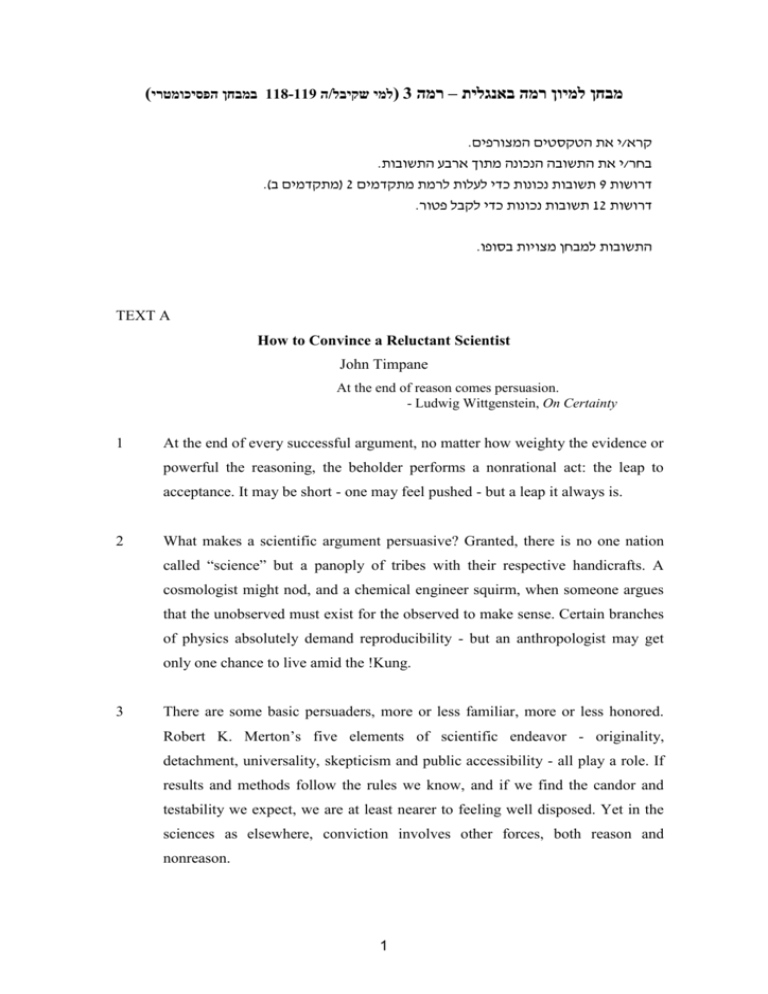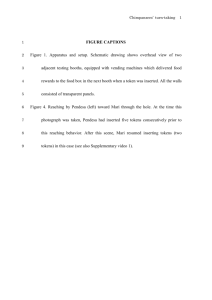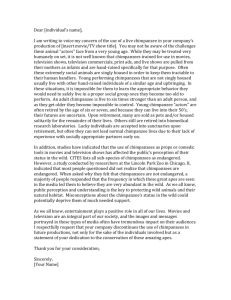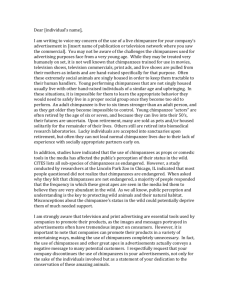Modernity`s Pyrrhic* Victory
advertisement

) במבחן הפסיכומטרי111-111 ה/ (למי שקיבל3 מבחן למיון רמה באנגלית – רמה .י את הטקסטים המצורפים/קרא .י את התשובה הנכונה מתוך ארבע התשובות/בחר .) (מתקדמים ב2 תשובות נכונות כדי לעלות לרמת מתקדמים9 דרושות . תשובות נכונות כדי לקבל פטור22 דרושות .התשובות למבחן מצויות בסופו TEXT A How to Convince a Reluctant Scientist John Timpane At the end of reason comes persuasion. - Ludwig Wittgenstein, On Certainty 1 At the end of every successful argument, no matter how weighty the evidence or powerful the reasoning, the beholder performs a nonrational act: the leap to acceptance. It may be short - one may feel pushed - but a leap it always is. 2 What makes a scientific argument persuasive? Granted, there is no one nation called “science” but a panoply of tribes with their respective handicrafts. A cosmologist might nod, and a chemical engineer squirm, when someone argues that the unobserved must exist for the observed to make sense. Certain branches of physics absolutely demand reproducibility - but an anthropologist may get only one chance to live amid the !Kung. 3 There are some basic persuaders, more or less familiar, more or less honored. Robert K. Merton’s five elements of scientific endeavor - originality, detachment, universality, skepticism and public accessibility - all play a role. If results and methods follow the rules we know, and if we find the candor and testability we expect, we are at least nearer to feeling well disposed. Yet in the sciences as elsewhere, conviction involves other forces, both reason and nonreason. 1 4 Our sense of what connects, what fits, what ramifies, can often move us to acceptance. Results that bear little connection to existing work will persuade little. But if study A forges connections between studies B, K and S, or if it newly illuminates an established fact, a tiny epiphany can happen. 5 Or a massive one. Sir Isaac Newton’s audience was impressed when he derived his laws of physics from observations made by Galileo - but overwhelmed when he then showed that the moon, planets and stars obeyed these same principles. It did not escape the notice of James D. Watson and Francis Crick that their proposed structure for DNA helped to explain the copying mechanism of the genetic material. Ramification may work also from without. If we realize the argument we have just heard is supported by independent evidence, our personal paradigms may start to budge. Some scientists initially resisted John Ostrom’s argument that the ancestors of modern birds were ground-dwelling theropods. But when we watch a hawk hop after a desert rat, we are not far from the awkward leap of Archaeopteryx. 6 To be persuasive, then, you can be only so original. Total originality, to the point at which no one else speaks your language, may cripple your argument’s progress in the world (as happened initially to Thomas Young’s wave theory of light). Call it the Law of Obviousness: better to be a half-step ahead and understood than a whole step and ignored. 7 Prestige sells, too. Freeman Dyson has noted the “profound consequences” of status in the sciences. A famous team at a famous institution backed by famous money is a hard combination to resist. Even harder is the status that comes with large projects. Almost irresistible is the assent of prestigious colleagues or superiors. 8 Publicity, for better or worse, begets prestige. Scientists today - of necessity are veritable master organists at the great keyboards of the media. Going public spurs debate, encourages verification, attracts funds. Today, when there is more science than ever before, a number of scientists see no alternative to invoking the “hosanna” and the “gee whiz”. 2 9 Many scientists believe arguments they have never read or heard, simply because most of their peers believe. As Thomas S. Kuhn writes, “There is no standard higher than the assent of the relevant community. The transfer of allegiance from one paradigm to another is a conversion experience that cannot be forced.” 10 And sometimes the sheer beauty of a demonstration can render an argument compelling. Einstein’s special theory of relativity gained acceptance not only by its power to explain observed phenomena but also by the elegance of the equation E=mci. Cell biologists wax rhapsodic over Erkki Ruoslahti’s experiments showing that a certain molecule, called an integrin, mediates the adhesion of cells to the protein fibronectin. Ruosleht’s work was of such beauty that other cell biologists found it extremely and immediately persuasive. 11 Much of what makes a scientific argument convincing, in the end, has to do with things other than science. By saying so, we do not impugn or undermine the sciences so much as we recognize their humanity. Some postmodernist thinkers - those, for example, who practice the collection of methods called deconstruction - believe that the important role of the nonrational in the sciences is a scandal, when in fact that role is fairly familiar to anyone who actually does a science for a living. 12 Besides, such conceptual issues cease to have much importance past the lab door, which opens into a world of different priorities. In the workplace, scientists have utter faith in the reality of the world and in themselves. They have to. (Otherwise, their experiments, and perhaps they, may turn to tar.) The order of things, furthermore, pressures them to treat all data, especially their own, with thorough skepticism. After all, these pragmatic, naive, realist skeptics must eventually submit their findings to another entity in which they trust - the candid, bruising machinery of peer review. 13 How, then, does the history of science unfold? According to reason, drawn by the ineluctable, magnetic pull of truth? Or by bursts, gaps, sudden nonrational 3 disjunctions? Perhaps the latter amounts to the former, since the aggregate of thousands of nonrational moments - when individual scientists are persuaded, convinced, converted - adds up to a progress of sorts. Conversion happens when a piece falls into place and renders the whole puzzle new. Often the new vision is so powerful that our decision to accept may seem hardly a decision at all. Yet a decision it always is. Precisely because they are not rational, such leaps - from final ice floe to riverbank - are wonderfully, deeply human. HOW TO CONVINCE A RELUCTANT SCIENTIST 01. What does the image in paragraph 2 of a nation made up of tribes refer to? 1) Different branches of physics 2) Different scientists working together 3) Different ways of doing science 4) Scientists of different nations 02. In this text, how does the writer develop his main idea? 1) by describing the different aspects of a convincing argument 2) by giving the reasons why it is difficult to argue with a scientist 3) by giving examples of scientists who have been convinced before 4) by telling of the changes in scientific thought throughout history 03. In order to be accepted by the scientific establishment, how should a scientist present his new ideas? 1) They should not go against generally accepted popular knowledge. 2) They should be linked in some way to other scientists' beliefs. 3) They must be original; otherwise they can be considered stolen. 4) They must be based on phenomena that are observable in the laboratory. 4 04. For what purpose is the concept of 'prestige' (paragraph 7) mentioned in the text? 1) as a reason why a scientist might have difficulties to convince his readers 2) as a position which most scientists work to achieve in their lifetime 3) as an obvious result of being a prominent scientist 4) as a factor which may convince other scientists of the value of an idea 05. According to paragraphs 8 and 9, which other factors does the writer introduce as promoting acceptance of arguments? 1) verification and funds 2) status and sufficient evidence 3) public attention and general assent 4) media and public debate 06. As the example of Einstein illustrates, why do scientists sometimes accept a theory? 1) They are struck by its power to generate other theories. 2) They are impressed by the name of the theorist who originated it. 3) They are sensitive to the power of its simple attractiveness. 4) They are assured that other scientists have accepted it as well. 07. What pressures scientists to treat their data with skepticism? 1) The demand to ignore the realities of the outside world. 2) The requirement to justify their work within the lab. 3) The need to receive the approval of other scientists. 4) The hope to truly achieve the research goals. 08. According to the writer, what leads to a scientific progress? 1) The reordering of all the pieces of the puzzle. 2) The accumulation of newly discovered facts. 3) The finding of the one missing piece which clarifies the whole issue at hand. 4) The decision to accept the most reasonable way of explaining the data. 5 TEXT B Coping with Crowding Frans B.M. De Waal, Filippo Aureli, and Peter G. Judge 1 In 1962 Scientific American published a seminar paper by experimental psychologist John B. Calhoun entitled “Population Density and Social Pathology.” The article opened dramatically with an observation by the late 18th-century English demographer Thomas Malthus that human population growth is automatically followed by increased vice and misery. Calhoun went on to note that although we know overpopulation causes disease and food shortage, we understand virtually nothing about its behavioral impact. 2 This reflection had inspired Calhoun to conduct a nightmarish experiment. He placed an expanding rat population in a cramped room and observed that the rats soon set about killing, sexually assaulting and, eventually, cannibalizing one another. Much of this activity happened among the occupants of a central feeding section. Despite the presence of food elsewhere in the room, the rats were irresistibly drawn to the social stimulation – even though many of them could not reach the central food dispensers. This pathological togetherness, as Calhoun described it, as well as the attendant chaos and behavioral deviancy, led him to coin the phrase “behavioral sink.” 3 In no time, popularizers were comparing politically motivated street riots to rat packs, inner cities to behavioral sinks and urban areas to zoos. Calhoun’s views soon became a central tenet of the voluminous literature on aggression. 4 In extrapolating from rodents to people, however, these thinkers and writers were making a gigantic leap of faith. A look at human population suggests why such a simple extrapolation is so problematic. Compare, for instance, per capita murder rates with the number of people per square kilometer in different nations – as we did, using data from the United Nation’s 1996 Demographic Yearbook. If things were straightforward, the two ought to vary in tandem. Instead there is no statistically meaningful relation. 6 5 But, one could argue, perhaps such a relation is obscured by variation in national income level, political organization or some other variable. Apparently not, at least for income. We divided the nations into three categories – free-market, former East Block and Third World – and did the analysis again. This time we did find one significant correlation, but it was in the other direction: it showed more violent crime in the least crowded countries of the former East Block. A similar trend existed for free-market nations, among which the U.S. had by far the highest homicide rate despite its overall low population density. The Netherlands had a population density 13 times as high, but its homicide rate was eight times lower. Perhaps because of the overriding effects of history and culture, the link between available space and human aggression – if it exists at all – is decidedly not clear-cut. 6 Calhoun’s model, we must conclude, does not generally apply to human behavior. Is this because our culture and intelligence make us unique, or is the management of crowding part of an older heritage? To answer this question, we turn to the primates. 7 We collected data on more than 100 chimpanzees in various groups at the Yerkes primate center. Although some groups had only a tenth the space of others, cramped quarters had no measurable impact on aggression. If crowding did induce social tensions, our chimpanzees seemed to control them directly. 8 We usually do not think of animals as holding in their emotions, but chimpanzees may be different. These apes are known for deceptive behavior – for instance, they will hide hostile intentions behind a friendly face until an adversary has come within reach. In our study, emotional control was reflected in the way chimpanzees responded to the vocalizations of neighboring groups. Such noises commonly provoke hooting and charging displays, which in wild chimpanzees serve to ward off territorial intrusion. 9 In a confined space, however, excited reactions trigger turmoil within the group. We found that chimpanzees in the most crowded situations had a three times 7 lower tendency to react to neighbors’ vocalizations than chimpanzees with more space did. Chimpanzees may be smart enough to suppress responses to external stimuli if those tend to get them into trouble. 10 The inhibition of natural responses is not without cost. We know that continuous stress has the potential to suppress the immune system and therefore has important implications for health and longevity. We developed two noninvasive techniques to measure stress in our chimpanzees. Both measures showed that groups of chimpanzees who had little space and heard neighbors’ vocalizations experienced more stress. Space by itself was not a negative factor, because in the absence of noisy neighbors, chimpanzees in small spaces showed the same stress level as those with a good deal of space. So even though chimpanzees fail to show a rise in aggression when crowded, this does not necessarily mean that they are happy and relaxed. 11 Our research leads us to conclude that we come from a long lineage of social animals capable of flexibly adjusting to all kinds of conditions, including unnatural ones such as crowded pens and city streets. The adjustment may not be without cost, but it is certainly preferable to the frightening alternative predicted on the basis of rodent studies. 12 We should add, though, that even the behavioral sink of Calhoun’s rats may not have been entirely the product of crowding. Food competition seemed to play a role as well. This possibility contains a serious warning for our own species in an ever more populous world: the doomsayers who predict that crowding will inevitably rip the social fabric may have the wrong variable in mind. We have a natural, underappreciated talent to deal with crowding, but crowding combined with scarcity of resources is something else. 8 COPING WITH CROWDING 09. What was the purpose of Calhoun’s experiment? 1) to observe how rats behave when they lack food. 2) to strengthen Malthus's population growth theory. 3) to understand how rats act under crowded conditions. 4) to study the social organization of lower animals. 10. According to the writers, how were Calhoun's conclusions concerning rats received by the public? 1) much was written about them, but no definite conclusions were drawn 2) the public thought that Calhoun's experiments explained human behavior 3) there was a large gap between scientists' and ordinary people's reaction 4) the public did not believe in the comparison of rats to humans 11. Why do the writers mention crime statistics in the U.S. and the Netherlands? 1) to show that it is the economy of a country that determines its crime rate 2) to show that they differ from the statistics for other parts of the world 3) to show that the behavior of rats is similar to that of human beings 4) to show the negative correlation between violence and population density 12. What did the writers' experiment with the chimpanzees prove? 1) that even under crowded conditions chimpanzees learn to manage stress 2) that an outside threat will usually lead chimpanzees to behave aggressively 3) that chimpanzees know how to hide their emotions in the face of danger 4) that chimpanzees are a generally content and satisfied type of animal 13. What kind of knowledge did the experiment with the chimpanzees confirm? 1) It is difficult to determine what causes the most stress. 2) Hiding aggressive feelings can be harmful to health. 3) Monkeys in captivity behave differently than in the wild. 4) There are no reliable measures of stress in human beings. 9 14. In paragraph 6, the writers ask a question. What is their answer to that question? 1) Humans manage to adapt their behavior in crowded conditions because of their superior intelligence. 2) Some human beings are more capable of adjusting to crowded environments than others. 3) Human beings' capability of coping with crowding is a consequence of their evolutionary process. 4) Human beings' behavior under stress shows better control than chimpanzees' behavior. 15. According to the writers, which factor can be a predictor of aggressiveness, both in rats and in human beings? 1) overpopulation 2) lack of food 3) social unrest 4) stress 10 ANSWER SHEET Answer 3 1 2 4 3 3 3 3 Question number 1 2 3 4 5 6 7 8 3 2 4 1 2 3 2 9 10 11 12 13 14 15 11







